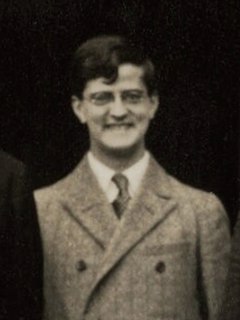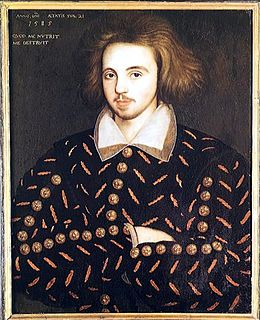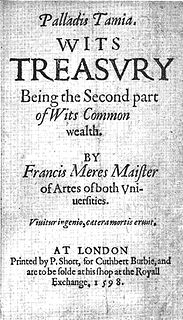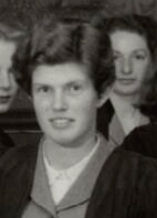
Christopher Marlowe, also known as Kit Marlowe, was an English playwright, poet and translator of the Elizabethan era. Marlowe is among the most famous of the Elizabethan playwrights. Based upon the "many imitations" of his play Tamburlaine, modern scholars consider him to have been the foremost dramatist in London in the years just before his mysterious early death. Some scholars also believe that he greatly influenced William Shakespeare, who was baptised in the same year as Marlowe and later succeeded him as the pre-eminent Elizabethan playwright. Marlowe was the first to achieve critical reputation for his use of blank verse, which became the standard for the era. His plays are distinguished by their overreaching protagonists. Themes found within Marlowe's literary works have been noted as humanistic with realistic emotions, which some scholars find difficult to reconcile with Marlowe's "anti-intellectualism" and his catering to the prurient tastes of his Elizabethan audiences for generous displays of extreme physical violence, cruelty, and bloodshed.

William Shakespeare was an English playwright, poet and actor. He is widely regarded as the greatest writer in the English language and the world's pre-eminent dramatist. He is often called England's national poet and the "Bard of Avon". His extant works, including collaborations, consist of some 39 plays, 154 sonnets, three long narrative poems, and a few other verses, some of uncertain authorship. His plays have been translated into every major living language and are performed more often than those of any other playwright. He remains arguably the most influential writer in the English language, and his works continue to be studied and reinterpreted.

Love's Labour's Lost is one of William Shakespeare's early comedies, believed to have been written in the mid-1590s for a performance at the Inns of Court before Queen Elizabeth I. It follows the King of Navarre and his three companions as they attempt to swear off the company of women for three years in order to focus on study and fasting. Their subsequent infatuation with the Princess of France and her ladies makes them forsworn. In an untraditional ending for a comedy, the play closes with the death of the Princess's father, and all weddings are delayed for a year. The play draws on themes of masculine love and desire, reckoning and rationalisation, and reality versus fantasy.

Alfred Leslie Rowse was a British historian and writer, best known for his work on Elizabethan England and books relating to Cornwall.

William Shakespeare (1564–1616) wrote sonnets on a variety of themes. When discussing or referring to Shakespeare's sonnets, it is almost always a reference to the 154 sonnets that were first published all together in a quarto in 1609. However, there are six additional sonnets that Shakespeare wrote and included in the plays Romeo and Juliet, Henry V and Love's Labour's Lost. There is also a partial sonnet found in the play Edward III.
This article contains information about the literary events and publications of 1598.

Love's Labour's Won is a lost play attributed by contemporaries to William Shakespeare, written before 1598 and published by 1603, though no copies are known to have survived. Scholars dispute whether it is a true lost work, possibly a sequel to Love's Labour's Lost, or an alternative title to a known Shakespeare play.

Henry Percy, 9th Earl of Northumberland, KG was an English nobleman. He was a grandee and one of the wealthiest peers of the court of Elizabeth I. Under James I, Northumberland was a long-term prisoner in the Tower of London, due to the suspicion that he was complicit in the Gunpowder Plot. He is known for the circles he moved in as well as for his own achievements. He acquired the sobriquet The Wizard Earl, from his scientific and alchemical experiments, his passion for cartography, and his large library.

Elizabethan literature refers to bodies of work produced during the reign of Queen Elizabeth I (1558–1603), and is one of the most splendid ages of English literature. In addition to drama and the theatre, it saw a flowering of poetry, with new forms like the sonnet, the Spenserian stanza, and dramatic blank verse, as well as prose, including historical chronicles, pamphlets, and the first English novels. Major writers include William Shakespeare, Edmund Spenser, Christopher Marlowe, Richard Hooker, Ben Jonson, Philip Sidney and Thomas Kyd.
Thomas Watson (1555–1592) was an English poet and translator, and the pioneer of the English madrigal. His lyrics aside, he wrote largely in Latin, also being the first to translate Sophocles's Antigone from Greek. His incorporation of Italianate forms into English lyric verse influenced a generation of English writers, including Shakespeare, who was referred to in 1595 by William Covell as "Watson's heyre" (heir). He wrote both English and Latin compositions, and was particularly admired for the Latin. His unusual 18-line sonnets were influential, although the form was not generally taken up.

The Marlovian theory of Shakespeare authorship holds that the Elizabethan poet and playwright Christopher Marlowe was the main author of the poems and plays attributed to William Shakespeare. Further, the theory says Marlowe did not die in Deptford on 30 May 1593, as the historical records state, but that his death was faked.
John Kerrigan, is a British literary scholar, with interests including the works of Shakespeare and Wordsworth. Since 2000, he has been Professor of English in the Faculty of English, University of Cambridge.
The Rival Poet is one of several characters, either fictional or real persons, featured in William Shakespeare's sonnets. The sonnets most commonly identified as the Rival Poet group exist within the Fair Youth group in sonnets 78–86. Several theories about these characters, the Rival Poet included, have been expounded, and scholarly debate continues to put forward both conflicting and compelling arguments. In the context of these theories, the speaker of the poem sees the Rival Poet as a competitor for fame, wealth and patronage.
William Shakespeare (1564–1616) was an English poet and playwright. He wrote approximately 39 plays and 154 sonnets, as well as a variety of other poems.

Sonnet 86 is one of 154 sonnets first published by the English playwright and poet William Shakespeare in the Quarto of 1609. It is the final poem of the Rival Poet group of the Fair Youth sonnets in which Shakespeare writes about an unnamed young man and a rival poet competing for the youth's favor. The exact date of its composition is unknown, it has been suggested that the Rival Poet series may have been written between 1598 and 1600.

Palladis Tamia: Wits Treasury; Being the Second Part of Wits Commonwealth is a 1598 book written by the minister Francis Meres. It is important in English literary history as the first critical account of the poems and early plays of William Shakespeare. It was listed in the Stationers Register 7 September 1598.
The School of Night is a play by Peter Whelan. It was first performed by the Royal Shakespeare Company at The Other Place, Stratford-upon-Avon on 4 November 1992.

The Shakespeare authorship question is the argument that someone other than William Shakespeare of Stratford-upon-Avon wrote the works attributed to him. Anti-Stratfordians—a collective term for adherents of the various alternative-authorship theories—believe that Shakespeare of Stratford was a front to shield the identity of the real author or authors, who for some reason—usually social rank, state security, or gender—did not want or could not accept public credit. Although the idea has attracted much public interest, all but a few Shakespeare scholars and literary historians consider it a fringe theory, and for the most part acknowledge it only to rebut or disparage the claims.

Patrick Gerard Cheney is an American scholar of English Renaissance Literature. He is Edwin Erle Sparks Professor of English and Comparative Literature at the Pennsylvania State University.

Roma Gill OBE, M.A. Cantab., BLitt. Oxon. was a British academic, writer and noted scholar on the works of Shakespeare and Marlowe. She edited more than 30 texts including three in the Oxford School Marlowe series and twenty-one in the Oxford School Shakespeare series, making these works more accessible to younger students. In addition, Gill was a prolific author of scholarly articles and reviews who during her prolific lecturing career inspired her many students with her passion for 16th-century literature. In her later life she developed multiple sclerosis which caused her great pain and disabled her to the extent she couldn't move and had to dictate the notes for her books.


















